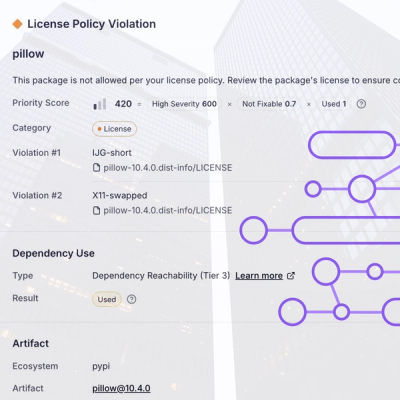
Research
/Security News
Critical Vulnerability in NestJS Devtools: Localhost RCE via Sandbox Escape
A flawed sandbox in @nestjs/devtools-integration lets attackers run code on your machine via CSRF, leading to full Remote Code Execution (RCE).
Veccie is a tiny sqlite extension implementing simple vector distance functions on float32 vectors encoded in BLOBs.
Implements the following functions:
dot_f32(a, b) -> a . bsqdist_f32(a, b) -> sum((a - b)^2)Where 'a' and 'b' are BLOBs containing vectors encoded as a concatenation of 32-bit IEEE floating point numbers. A native sqlite (double precision) float is returned.
sqlite-veccie Python libraryThe sqlite-veccie Python package may be obtained from PyPI or built from
source (letting setuptools figure out the local compiler incantation).
The module can then be used directly with the built-in sqlite3
module, the excellent
apsw or any other SQLite library.
>>> import sqlite3
>>> import sqlite_veccie
>>> # Load the plugin
>>> con = sqlite3.connect("example.db")
>>> con.enable_load_extension(True)
>>> con.load_extension(sqlite_veccie.path)
>>> # Create a table with 100,000 random 512-dimensional vectors
>>> import numpy as np
>>> con.execute("CREATE TABLE example(id INTEGER PRIMARY KEY, vector BLOB NOT NULL)")
>>> con.executemany(
... "INSERT INTO example VALUES (?, ?)",
... [
... (id, vector.astype(np.float32).tobytes())
... for id, vector in enumerate(np.random.random((100_000, 512)))
... ]
... )
>>> con.commit()
>>> # Find the 10 vectors closest to the vector (0, 0, 0, ...)
>>> print(
... con.execute(
... """
... SELECT id, sqdist_f32(vector, ?) AS distance
... FROM example
... ORDER BY distance
... LIMIT 10
... """,
... (np.zeros(512, dtype=np.float32).tobytes(),),
... ).fetchall()
... )
You can build veccie.c like any other SQLite
extension,
for example, under Linux you can use:
$ gcc -g -fPIC -shared -O3 veccie.c -o veccie.so
You must have the sqlite3ext.h header in your include path.
You can also pull the ready-made binary out of the installed sqlite_veccie
Python package: use python -m sqlite_veccie to print its filename.
Once built you can use it directly in SQLite like so:
$ sqlite example.db
sqlite> .load ./veccie.so
sqlite> CREATE TABLE example(id INTEGER PRIMARY KEY, vector BLOB NOT NULL);
sqlite> INSERT INTO example VALUES (0, x'0000000000000000'); -- (0.0, 0.0)
sqlite> INSERT INTO example VALUES (1, x'0000803f0000803f'); -- (1.0, 1.0)
sqlite> INSERT INTO example VALUES (2, x'0000004000008040'); -- (2.0, 4.0)
sqlite> -- Get the distance of each vector from 1.0, 1.0
sqlite> SELECT id, sqdist_f32(vector, x'0000803f0000803f') FROM example;
0|2.0
1|0.0
2|10.0
These functions happen to be the distance metrics for the embeddings used by my clippie and faceie implementations of CLIP and FaceNet respectively.
It turns out that you don't need a fancy vector database when your dataset only
consists of a few hundred thousand or million vectors: brute-force search is
shockingly fast. For exapmle, calling dot_f32 or sqdist_f32 on every
512-dimensional vector in a 100,000 row table only adds about 30ms(!) to the
query runtime on my laptop.
This library is another piece in the collection of parts which I'm building up as the basis for a personal photo library program. Adding these functions makes it possible to use SQLite to store and query both photo metadata and vector embeddings in one robust, performant and long-lived system.
The functions implemented by this extension require the floats within the BLOBs passed to them to be in the machine's native byte order. This makes any database using this format non-portable between architectures with different byte orderings. Luckily for me, I only have little-endian machines to hand so this isn't a problem...
No particular claims are made about the numerical quality of the implementation of these functions. Again, luckly I'm using these on fairly noisy data (vector embeddings) where this doesn't really matter.
The implementation of the dot product and square distance functions is pretty much as simple as it gets. Most compilers will do a good job of vectorising this yielding pretty good performance. There is still room for improvement: numpy's dot product implementation is about three times faster, at least when run on a very large batch of vectors.
I've not yet faffed with GitHub actions to automatically build binary wheels for all common platforms. (Contributions welcome...)
FAQs
A tiny sqlite extension implementing simple vector distance functions
We found that sqlite-veccie demonstrated a healthy version release cadence and project activity because the last version was released less than a year ago. It has 1 open source maintainer collaborating on the project.
Did you know?

Socket for GitHub automatically highlights issues in each pull request and monitors the health of all your open source dependencies. Discover the contents of your packages and block harmful activity before you install or update your dependencies.

Research
/Security News
A flawed sandbox in @nestjs/devtools-integration lets attackers run code on your machine via CSRF, leading to full Remote Code Execution (RCE).

Product
Customize license detection with Socket’s new license overlays: gain control, reduce noise, and handle edge cases with precision.

Product
Socket now supports Rust and Cargo, offering package search for all users and experimental SBOM generation for enterprise projects.